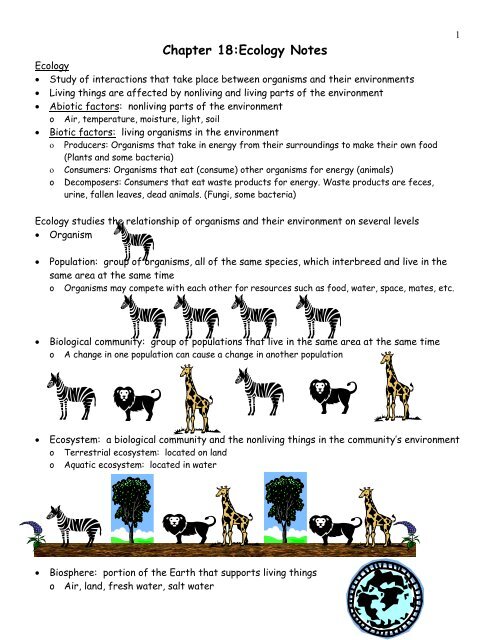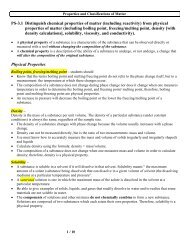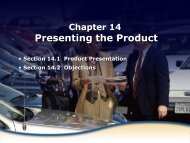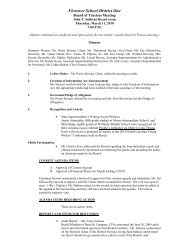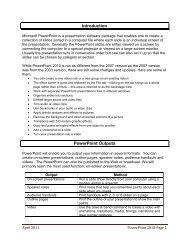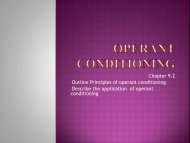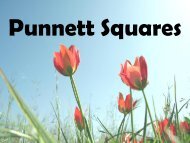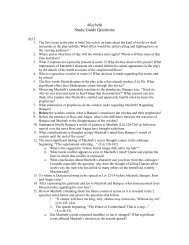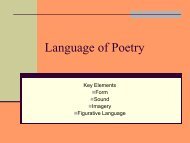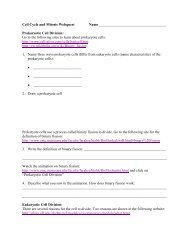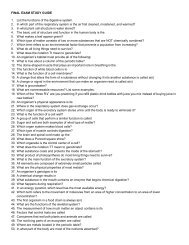Chapter 2: Principles of Ecology
Chapter 2: Principles of Ecology
Chapter 2: Principles of Ecology
You also want an ePaper? Increase the reach of your titles
YUMPU automatically turns print PDFs into web optimized ePapers that Google loves.
<strong>Chapter</strong> 18:<strong>Ecology</strong> Notes<br />
<strong>Ecology</strong><br />
Study <strong>of</strong> interactions that take place between organisms and their environments<br />
Living things are affected by nonliving and living parts <strong>of</strong> the environment<br />
Abiotic factors: nonliving parts <strong>of</strong> the environment<br />
o Air, temperature, moisture, light, soil<br />
Biotic factors: living organisms in the environment<br />
o Producers: Organisms that take in energy from their surroundings to make their own food<br />
(Plants and some bacteria)<br />
o Consumers: Organisms that eat (consume) other organisms for energy (animals)<br />
o Decomposers: Consumers that eat waste products for energy. Waste products are feces,<br />
urine, fallen leaves, dead animals. (Fungi, some bacteria)<br />
1<br />
<strong>Ecology</strong> studies the relationship <strong>of</strong> organisms and their environment on several levels<br />
Organism<br />
<br />
Population: group <strong>of</strong> organisms, all <strong>of</strong> the same species, which interbreed and live in the<br />
same area at the same time<br />
o Organisms may compete with each other for resources such as food, water, space, mates, etc.<br />
<br />
Biological community: group <strong>of</strong> populations that live in the same area at the same time<br />
o A change in one population can cause a change in another population<br />
<br />
Ecosystem: a biological community and the nonliving things in the community’s environment<br />
o Terrestrial ecosystem: located on land<br />
o Aquatic ecosystem: located in water<br />
<br />
Biosphere: portion <strong>of</strong> the Earth that supports living things<br />
o Air, land, fresh water, salt water
2<br />
Habitat<br />
the place where an organism lives out its life<br />
Niche: all the strategies and adaptations a species uses in its environment<br />
o Includes all its interactions with the biotic and abiotic parts <strong>of</strong> the environment<br />
o Each type <strong>of</strong> organism occupies its own niche to avoid competition with other types <strong>of</strong><br />
organisms<br />
Two species can share the same habitat but not the same niche<br />
o Example: Ants and bacteria both live in the dirt (habitat) but have different niches.<br />
Ants eat dead insects and bacteria eat dead leaves, dead logs, and animal waste. So<br />
ants and bacteria don’t compete for resources.<br />
Survival relationships<br />
Predator-prey: predators are consumers that hunt and eat other organisms called prey<br />
Symbiosis: relationship in which one species lives on, in, or near another species and<br />
affects its survival<br />
o There are 3 types <strong>of</strong> symbiosis<br />
1. Mutualism: type <strong>of</strong> symbiosis in which both species benefit<br />
‣ Ants living in the tropical acacia trees- trees are protected when ants attack<br />
animals that try to feed on the tree and ants receive nectar and shelter from the<br />
tree.<br />
2. Commensalism: type <strong>of</strong> symbiosis in which one species benefits and the other species<br />
is neither harmed nor benefited<br />
‣ Spanish moss grows on the branches <strong>of</strong> trees. The moss gets a habitat and the<br />
tree gets nothing.<br />
3. Parasitism: type <strong>of</strong> symbiosis in which one species benefits and the other species is<br />
harmed<br />
‣ Parasite: organism that harms but does not kill another organism<br />
‣ Host: organism that is harmed by a parasite<br />
‣ Ticks feed on dogs, people, etc. The ticks get food (blood) and the hosts lose<br />
blood and can be infected with disease.<br />
Feeding relationships<br />
Autotrophs: Organisms that make their own food (plants and some bacteria)<br />
Heterotrophs: Organisms that cannot make their own food and must eat other organisms<br />
o Herbivores: eat plants (cows)<br />
o Carnivores: eat meat (wolves)<br />
o Omnivoes: eat plants and meat (humans)
Bacteria<br />
Food Chains<br />
Trophic levels and food chains<br />
• Trophic level: A feeding level in an ecosystem<br />
• Food chain: lineup <strong>of</strong> organisms that shows who eats who<br />
o Shows how matter and energy move through an ecosystem<br />
3<br />
Eaten<br />
by<br />
1 st trophic level:<br />
producers<br />
(make their own<br />
food)<br />
Eaten<br />
by<br />
2 nd trophic<br />
level: primary<br />
consumer<br />
(eats plants)<br />
3 rd trophic<br />
level: secondary<br />
consumer (eats<br />
meat)<br />
Eaten<br />
by<br />
4 th trophic<br />
level: tertiary<br />
consumer (eats<br />
meat)<br />
Eaten<br />
by<br />
Last trophic<br />
level:<br />
decomposer<br />
(eats dead<br />
animals)
Energy pyramid<br />
• Every time an organism eats, it obtains energy from its food<br />
• So energy is transferred from the 1 st trophic level to the 2 nd trophic level to the 3 rd<br />
trophic level and so on.<br />
• Some <strong>of</strong> this energy is lost along the way during an organism’s metabolism and as heat<br />
• Energy pyramid: picture showing how much energy is transferred to the different<br />
trophic levels in a food chain<br />
4<br />
Trophic Level<br />
4 th<br />
Tertiary<br />
consumers<br />
Energy Available<br />
10 kcal/m 2 /year<br />
2 nd<br />
Primary<br />
consumers<br />
1 st<br />
Producers<br />
3 rd<br />
Secondary<br />
consumers<br />
100 kcal/m 2 /year<br />
1000 kcal/m 2 /year<br />
10,000<br />
kcal/m 2 /year
Food web<br />
• A network <strong>of</strong> connected food chains<br />
• More realistic than a food chain because most organisms feed on more than one<br />
species for food<br />
5<br />
Limiting Factors<br />
There is only a limited amount <strong>of</strong> resources (water, oxygen, nitrogen, carbon) on the earth<br />
Carrying capacity – number <strong>of</strong> organisms <strong>of</strong> 1 species that an environment can support<br />
Populations increase below the carrying capacity<br />
Population decrease above the carrying capacity<br />
Limits <strong>of</strong> the environment<br />
Reproductive patterns<br />
Example: Mosquitoes reproduce rapidly, and Elephants reproduce very slowly<br />
Density Dependent Factors – the more dense, the more it spreads<br />
o Disease – spreads in a tighter community<br />
o Competition – more people, the more competition<br />
o Parasites<br />
o Food<br />
Density Independent Factors – affect all populations regardless <strong>of</strong> their density<br />
o temperature<br />
o storms<br />
o floods<br />
o drought<br />
o habitat disruption<br />
o pollution<br />
Predation – when predators eat the prey, the prey decreases, but can this decrease the<br />
predator population as well?<br />
Crowding – when populations become crowded, stress <strong>of</strong> the animal increases, it can<br />
become very aggressive, decrease its parental care, decrease its fertility, and resistance<br />
to disease decreases
Ch. 18 Notes-Part II<br />
Succession<br />
What is succession? Changes over time. Succession can occur in decades or even centuries.<br />
It can take a really long time.<br />
If you didn’t cut the grass, what would happen to it?<br />
1) It would grow larger<br />
2) Weeds would start to grow<br />
3) The area will look like a meadow<br />
4) Bushes will grow<br />
5) Trees will appear<br />
6) Less light will reach the ground b/c<br />
<strong>of</strong> the trees<br />
7) The grass will slowly disappear<br />
8) The area will become a forest<br />
Stages <strong>of</strong> succession<br />
1) Primary succession – colonization <strong>of</strong> new sites by organisms<br />
Example) Lava from a volcano, an avalanche makes new territory for organisms<br />
2) Climax Community – A stable, mature community that undergoes little or no change in<br />
species<br />
3) Secondary succession – sequence <strong>of</strong> community changes that takes place after a<br />
community is disrupted by natural disasters or human actions (occurs in areas that<br />
previously contained life, and on land that contains soil)<br />
Example) Forest fire, hurricanes, farmers abandon a field, a building is demolished<br />
BIOLOGICAL DIVERSITY & CONSERVATION<br />
Biodiversity – variety <strong>of</strong> life in an area (More biodiversity in the warmer environments)<br />
Threatened species-Endangered species-Extinct species<br />
Threats to Biodiversity<br />
1) Habitat loss – when rainforests and coral reefs are wiped out<br />
2) Habitat fragmentation – separation <strong>of</strong> wilderness areas from other wilderness areas<br />
(like islands)<br />
3) Edge effect – when climate is changed along the edge <strong>of</strong> an ecosystem<br />
4) Habitat degradation – damage to a habitat by pollution<br />
5) Introduction <strong>of</strong> exotic animals – introducing a new species into an ecosystem<br />
Conservation biology – new field that studies method and implements plans to protect<br />
biodiversity<br />
How to conserve<br />
1) Legal protection – no one can hunt or kill any animal on the endangered species list<br />
2) Preserving habitats – installing national parks<br />
3) Reintroduction programs – bringing species back to where they once lived<br />
4) Captivity – people holding onto organisms in a zoo<br />
Cycles in nature<br />
There is only a limited amount <strong>of</strong> resources (water, oxygen, nitrogen, carbon) on the earth<br />
In order to keep these resources available to organisms, they must be recycled after they<br />
are used<br />
Cycle: a process that recycles a resource so that you end up with what you started with<br />
6
Nitrogen Cycle<br />
7<br />
1. Nitrogen fixation: Bacteria in the<br />
ground change nitrogen from the<br />
atmosphere (N 2 ) to different nitrogen<br />
compounds<br />
5. Denitrification: Bacteria change the<br />
nitrogen compounds back to N 2 and<br />
release it to the atmosphere<br />
2. These bacteria live in plants and<br />
transfer the nitrogen compounds to the<br />
plants<br />
4. Bacteria eat the dead animals and<br />
animal waste and take in the nitrogen<br />
compounds<br />
3. Animals eat the plants and take in the<br />
nitrogen compounds<br />
Bacteria change nitrogen compounds<br />
back to nitrogen and release it into<br />
the atmosphere<br />
Bacteria eat<br />
dead animals<br />
Nitrogen in<br />
atmosphere<br />
Bacteria in roots change<br />
nitrogen to nitrogen<br />
compounds
Water Cycle<br />
8<br />
2. Seepage: Water<br />
seeps into the<br />
ground and plants<br />
use it<br />
3. Transpiration:<br />
Plants give <strong>of</strong>f<br />
water to the<br />
atmosphere<br />
1. Precipitation: Rain and snow fall from<br />
the atmosphere to the earth<br />
2. Run<strong>of</strong>f: Extra<br />
water runs <strong>of</strong>f the<br />
land to lower-lying<br />
bodies <strong>of</strong> water<br />
3. Evaporation <strong>of</strong><br />
water from the<br />
bodies <strong>of</strong> water<br />
back into the<br />
atmosphere
Oxygen-Carbon Cycle<br />
9<br />
1. Carbon dioxide (CO 2 )<br />
and oxygen (O 2 ) are<br />
found in the atmosphere<br />
2. Plants use CO 2 to<br />
make their own food<br />
(photosynthesis)<br />
2. Animals and plants<br />
use the O 2 to make<br />
energy (respiration)<br />
3. During photosynthesis,<br />
plants release O 2 back into the<br />
atmosphere<br />
3. During respiration, animals<br />
and plants release CO 2 back<br />
into the atmosphere


